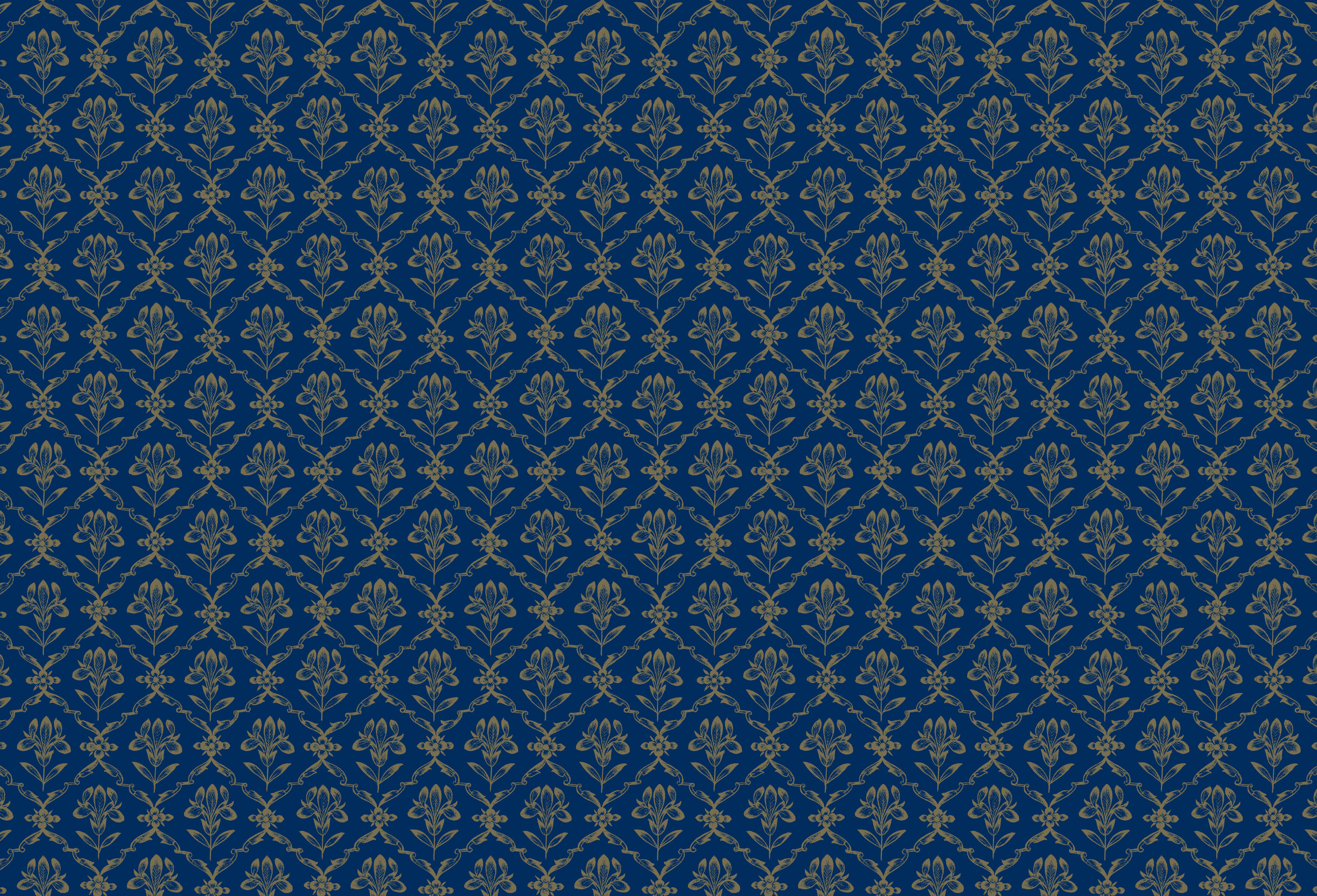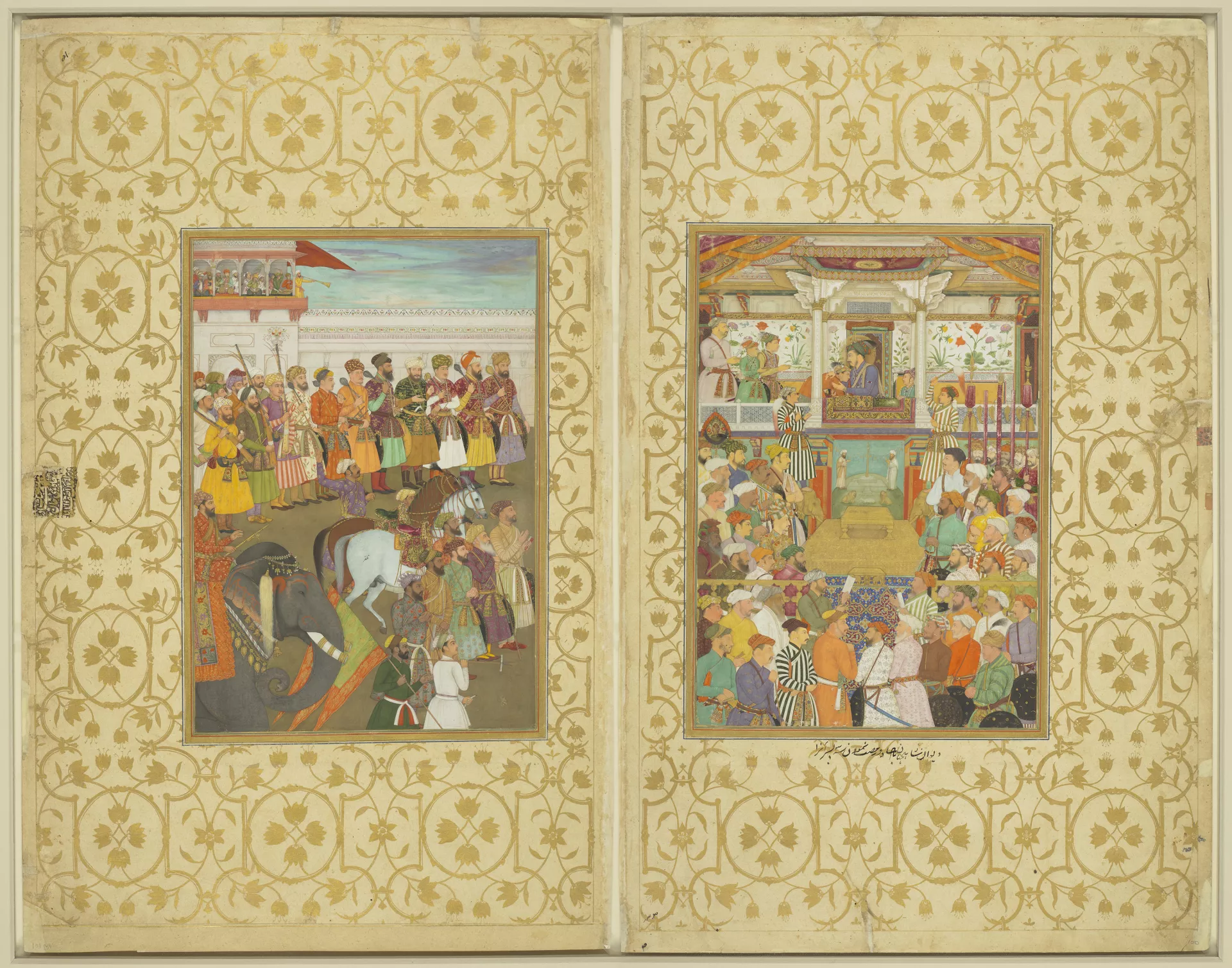
Drawn from the Royal Library's collection of South Asian books and manuscripts
Shah-Jahan receives his three eldest sons and Asaf Khan during his accession ceremonies by Bichitr and Ramdas
Mughal, <i>c.</i>1630–40Fols 50v and 51r from a manuscript of the Padshahnama (see cat. no. 26) | Paintings in opaque watercolour including gold and silver metallic paints with decorative incising on paper; set into margins of gold metallic paint on paper with black ink inscription | 50v: 58.3 × 36.8 cm (folio); 30.6 × 21.1 cm (image); 51r: 58.2 × 36.8 cm (folio); 30.6 × 21.4 cm (image) | RCINS 1005025.k and 1005025.l
Shah-Jahan ascended the Mughal throne after the death of Jahangir on 8 November 1627. This painting depicts a durbar held as part of his formal accession ceremonies staged at the Agra Fort the following spring. The bird in the shamsa of the canopy above the Emperor’s head represents the huma, the auspicious bird of paradise. According to Iranian tradition, whoever’s head the huma bird flies over will become a great king. The gold platform in front of Shah-Jahan is where the mullah will come to read the khutba (‘Friday sermon’) in the Emperor’s name for the first time as a declaration of his sovereignty. This will then be issued to mosques across the empire’s provinces to inform them of Shah-Jahan’s accession.
The text describes how the new Emperor’s three eldest sons, Dara-Shukoh, Shah-Shuja and Aurangzeb each in turn kissed the ground and presented their father with a nazr of gold coins. The painter Bichitr depicts Shah-Jahan kissing Dara-Shukoh, his eldest son and heir apparent, on the forehead while the others look on. Jahangir had kept his grandsons as hostages in Lahore while their father was in exile following his rebellion in 1622. On the far left of the balcony is Asaf Khan, Shah-Jahan’s father-in-law, who played a central role in his coming to power after Jahangir’s death and who escorted the Princes from Lahore to Agra for the accession events. This painting therefore commemorates an important reunion after almost six years of separation. The Padshahnama text describes the delight of Shah-Jahan and his wife Mumtaz-Mahal seeing their sons for the first time the day before this ceremony took place: ‘The parents’ joy after such a long time was indescribable inasmuch as in the workshop of rhetoric there is no expression that can convey such joy. The entire day was spent by the parents admiring the beauty of their grand sons.’[108] On the right of the Emperor is Prince Murad Bakhsh, then only three years old, meeting his brothers for the first time.
During imperial durbars, the emperor always sat in the high jharokha at the centre of the hall of public audience where he could preside over the ceremony. Below him to the left and right, attendants hold imperial insignia including the sunshade (aftab-gir) and standards (alam) wrapped in scarlet cloth. Other servants, seen here standing on two gold elephants, would fan the emperor as he sat. A strict hierarchy governed who stood where and in what proximity to the emperor during the ceremony, with nobles of highest rank positioned nearest. In this painting many of the figures are named in tiny inscriptions, allowing us to identify two Rajput rajahs closest to the Emperor on the left: Gaj Singh of Jodhpur, cousin of the Emperor, and Ratan Singh of Bundi, who travelled from his homeland to Agra to pay homage to the Emperor on his accession. First on the right is the Iranian Zamana Beg, known as Mahabat Khan, whom Shah-Jahan appointed his commander-in-chief (khan-e khanan sipahsalar). Standing by the railings at the centre are the officers recording the events of the ceremony. Outside the railings are the lesser nobles. During less formal durbars, those with petitions or seeking audiences with the emperor would have stood beyond a second rail.
Most durbar scenes from Shah-Jahan’s reign conform to the same compositional formula: the Emperor positioned at the top of the central axis with his nobles below him in what can often be read as a pyramid or circular arrangement which the Emperor completes, the strict hierarchy and geometric balance confirming Shah-Jahan as head of a centralised, harmonious state.[109] The artist of this work, Bichitr, a technically brilliant draughtsman, captures the rigid formality of the ceremony.[110]
Unlike Payag (cat. no. 29), Bichitr uses colours of uniformly bright intensity, purposefully flattening the surface with his two-dimensional depiction of textile patterns and strictly upright figures emphasising the vertical planes.[111] The figures would have all been traced from single portraits of the type seen in cat. nos 24 and 26, the only ones apparently drawn from his imagination being the anonymous standard-bearers.
The other side of this double opening was painted by Ramdas, whose name is written in devanagari script on the folder held by the figure dressed in white on the far right, presumably a self-portrait of the artist.[112] Again, the figures stand hierarchically in a semicircle, the official with his notebook positioned at the front with a group of nobles. Behind them are gifts of two royal horses (one of which is named zafar, ‘victor’) with jewelled saddles, an elephant with rich trappings and a royal standard. The Padshahnama does not mention an exchange of grand gifts during the ceremony in which Shah-Jahan received his three sons, and it is likely that this painting was not originally intended to form a pair with Bichitr’s. The extremities of the courtyard are guarded by a row of mace-bearers and soldiers, the faces of whom are wonderfully individualised and animated. At the top left is the naubat-khana, where the naubat (‘music ensemble’) provide an aural accompaniment to the lengthy ceremonies. The naqqara (‘kettle drum’) was an overt imperial symbol, the beating of which signified the presence of the emperor.
raqam-e banda-ye kamtarin Bichitr / drawn by the most insignificant slave Bichitr
majles-e julus-e aqdas-e wala-ye hazrat-e shahinshah-ye khalifat panahi-ye saya-ye aftab zill ilahi u sa’adat-e andukhtan-e shahzadaha-ye kamkar-e rafiqadr-e ali miqdar az mulazamat-e sahib-qiran-e sulayman-iqtidar u sarafrazi yaftan-e khankhanan-e siphasalar az zaminbos-e in asitan-e zamin-a siman-e arsh-istiqrar / assembly of the most blessed accession of His Most Exalted Majesty Shah-Jahan, refuge of the caliphate, shadow of the sun, shadow of God, and the attainment of felicity by the exalted princes through paying homage to Sahib-Qiran as mighty as Solomon, and the enoblements of Khankhanan, master of the army, by kissing the ground before the heavenly threshold as stable as the divine throne.
[108] Translated by Wheeler Thackston in Beach and Koch 1997, p. 38.
[109] See Koch 1997.
[110] For Bichitr see Okada 1992, pp. 165–70. One of Bichitr’s most famous paintings, ‘Jahangir Preferring a Sufi Shaykh to Kings’ (Freer Sackler F1942.15) contains a depiction of James I.
[111] See Minissale 2007, pp. 91–2.
[112] This was only attributed to Ramdas in Beach and Koch 1997 because of its perceived similarity to his painting on fol. 48v.
Bibliographic reference(s)
Beach and Koch 1997, pp. 38, 167–9; Welch 1995, p. 322





